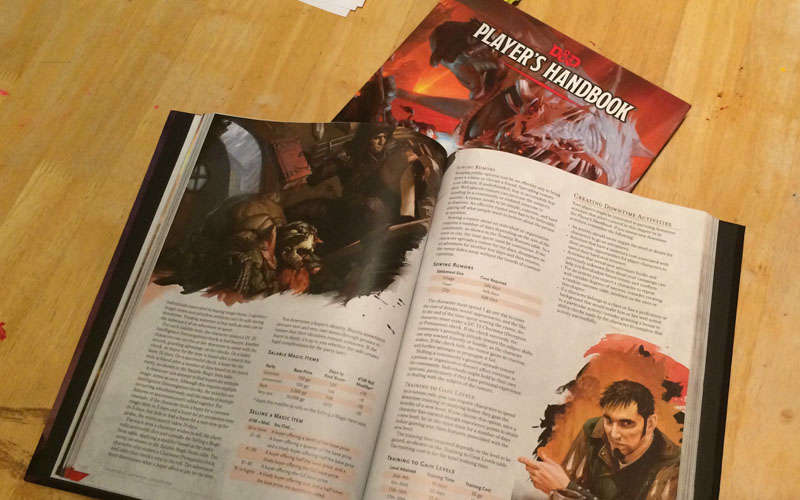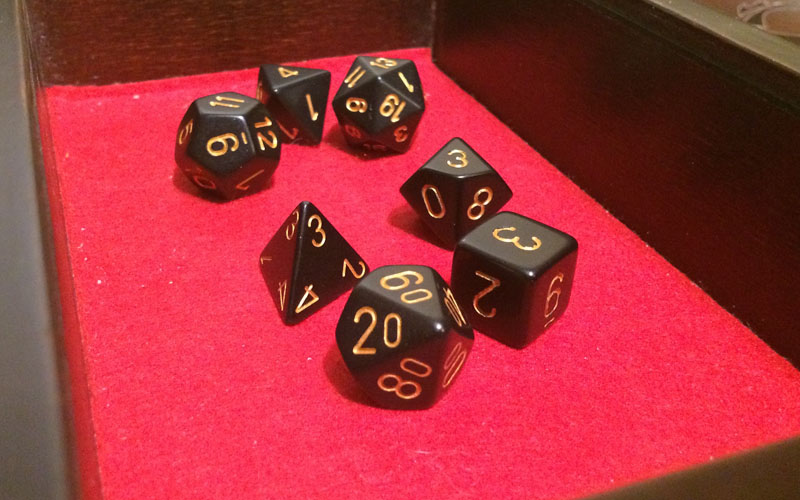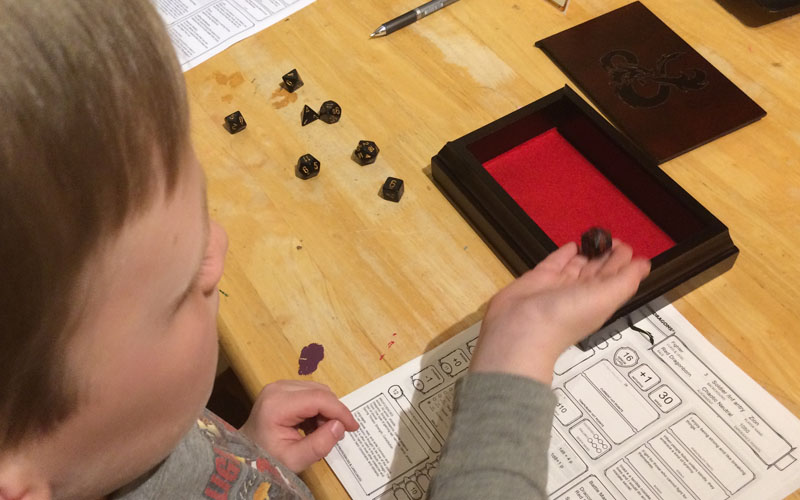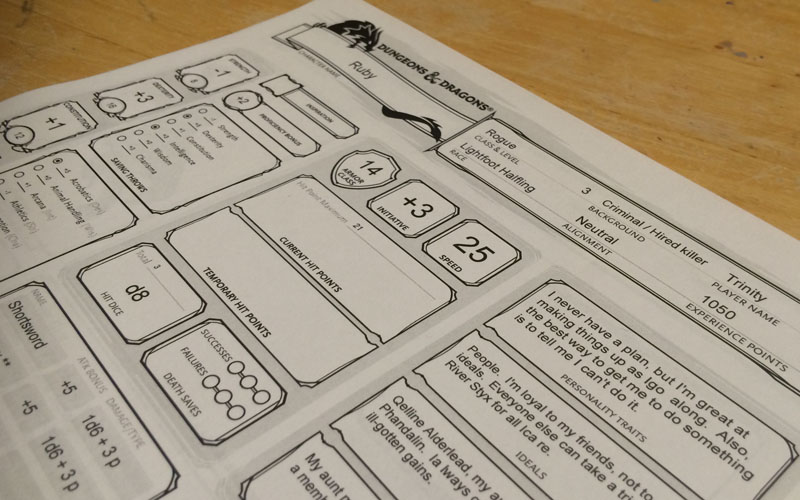I was at the prime young age of 12, and the big rage in middle school was this new game called “Dungeons & Dragons.” The problem? My wonderful conservative Mom was concerned with all of the satanic looking monsters, so she didn’t let me play. I didn’t put up much more than a small fuss about it. I quickly moved on to other interests, picking up the electric bass instead.
However, secretly I always wondered what the game was all about. Also, deep down inside, I always wondered if the game was horribly inappropriate for kids or would somehow lead to kids turning out “bad.”
Fast forward about 30 years…
I’m now happily married and have 3 awesome kids, ages 7, 9, and 12. Life is good. An opportunity came up last year where I needed to learn to play D&D for my job. It was “research” for my job in video game design.
Wait a second! What would my Mom think? I’m a big boy now, gosh darn it, so I can do this if I want to! Sweet!!
I grabbed the 5th Edition Players Handbook and read it through, then played a D&D Adventure League session in a nearby gaming store. I soon realized that this game was so much more than I had realized it was. It was so awesome!

My kids were intrigued by my new game when I explained it to them. Then it hit me, I was in the exact situation my parents were in 3 decades earlier. I knew it wasn’t the “evil” game that my parents had thought it was. It was time to make a different choice.
I DM’d a few games with my kids, coaching them along the way. When it was over and had time to think about the gameplay, I realized how beneficial this game is for my kids and their development. Explained in layman’s terms so non-D&D-playing parents can understand, here is what I found.
Using Imagination
This is the big one! The world of D&D is played through storytelling. The players, as well as the Dungeon Master (lead storyteller that runs the game) all get to tell part of the story. They each have to pull from their imaginations to explain the details of what their character is doing. Kids with wild imaginations have a place to express it. Kids with limited imaginations can be inspired by all the cool stuff going on and want to participate in it.
Imagination can also be used to reduce violence. My daughter was in her first combat with a monster and said, “I don’t want to kill them. Is that ok?” I told her that she could describe any action she wanted and when they were “tired” enough you could just bonk them on the head and knock them out. That made her happy. For many rounds battles would be described in fun creative ways, that were not as bloody as adults play.
or
or
Teamwork and Social Skills
D&D is all about playing with friends and interacting with others. Everyone has a part to play, and must contribute if everyone is to succeed. The Barbarian in the party will be at the forefront of the fight, while the Sorcerer distracts the monsters with her magic, and the Cleric will stay back and help heal everyone. The players have to talk and figure out what to do to succeed. It’s always a cool moment when a big monster goes down and everyone knows they did their part.
Math Skills
D&D is played with 7 kinds of dice, d4 d6, d8, d10, d10(percentage), d12, and d20, named by the number of sides they have. In the game, to see if you hit your enemy, you need to roll a d20 and add your strength and proficiency bonuses. If you hit you need to roll for damage, which might be 1d8 plus 2d6 bonus dice plus your strength modifier, and add them up. But the monster is resistant to fire damage, so you have to cut that number in half. How much damage should he get?
BAM! Math.

Easy for a middle-schooler, but definitely an excellent brain-stretch for elementary kids. Heck, every time I roll, it takes me a second or two to calculate it. Additionally, it may not be that obvious at first, but they’re also getting real-world experience of how probability and statistics work through how frequently numbers appear during dice rolls.
Life Doesn’t Always Go As Planned
Isn’t that the honest truth. During D&D gameplay you roll a d20 dice to see if your actions are successful or not. Rolling a 1 on a 20-sided dice is called a natural 1, and an instant failure. They always seem to happen at the most inconvenient times. Not only is it a fail, but the Dungeon Master usually improvises a hilarious story moment to accent the failure.
These moments always get a laugh from all the players, but for kids it’s all about what you do next. It is an opportunity to turn it around. Do they lie there and wait to be trampled? Or do they brace their sword into the ground sticking up ready for the Giant to stomp them?
They now have turned something bad into something good and it was a positive experience. We all know how important a life skill it is to make lemonade out of lemons.
Crazy Decisions with Minimal Consequences
Every parent can relate to these phrases. Our day to day life has become filled with them.
What if there were no limits? What if you could try to jump off a cliff, try to grab an exposed tree branch on the way down, do a backflip and land on the ground? What if, the worst that could happen would be you had to wait a few minutes for your friend to “heal” you? I’d do it in a heartbeat just to see what happened! Let kids describe their wildest and craziest actions, and in return give them fun, creative consequences. When else will they be able to “do” things like this?

Challenging Rules
Life is full of rules. From the laws of your country, and state, down to the employee handbook at work and the rules of your household. We’re told to follow rules, and in many cases, the reason we are told is simply “because I said so.” When you’re an adult, you get to challenge the status quo. State your case, and if make a convincing enough argument you are able to “change the world,” or at very least change your own destiny.
It will be many years before our children will have the charisma, ability, or maturity to make such impactful changes in the real world. Why not give them the opportunity to do this as part of play? Let them challenge how the DM handles part of the adventure, and let them change their fate by offering alternatives.
DM:
Player:
Most importantly, let them work for it, but after they’ve had a bit of a struggle, let them succeed. They will have pride in succeeding challenging authority and winning, in a positive way. The DM is the rules master, and they can choose to make any rules change they wish to suit the situation. Challenging authority is a skill that can be crafted in youth during play, so that when it matures, it becomes respectful and productive. D&D can help develop this skill.
Problem Solving
Every corner of a D&D adventure has challenges, problems to solve, and mysteries to unravel.
Player:
Combined with their knowledge of their character, their companions, and their resources, I’ve been astonished to see what kinds of absolutely outside the box solutions kids can come up with. Heck, I like to play with kids because they teach *me* how to think more creatively while problem solving.

Choose Your Words Carefully
Without caution during the game, the kids yell, “Kill him and take his money!”
DM:
Players:
The flipside of making crazy decisions with minimal consequences, is, well, learning to chose your words carefully when talking with other characters. Learn to think things through before you speak… otherwise you’ll have to continue to rely on your creativity to get out of sticky situations.
Role Playing to Express Feelings
It is a well known tool for therapists to use role playing to help release feelings. When kids get to “be somebody else” they are free to behave differently than they normally do or do things they normally would not be allowed to do. This can be a huge outlet for them.

Also, you can play a character that is not a Human, but a Dragonborn or a Half-Orc. Sometimes, when you encounter other NPC’s (non-player characters), they may not like your race and might treat you poorly because of it. It’s a safe way to help kids understand how racism affects people through role playing.
…and the Big “But”
Every child is different. They each have different needs and respond to various experiences in different ways. Some are better at separating reality from fantasy, some are not. These abilities are always changing so we need to keep a pulse on them. I always try to keep a keen eye on my kids behavior before and after we do something new or unusual to make sure they can handle it. D&D is no exception.
I talk with them about the experience, see if they liked it, or if there was anything that scared them. What was their favorite part, and their least favorite part? I ask them several days later about it, and just watch their initial reaction. Did their face light up, or did they wince? I watch their demeanor over the following week to see if they are more irritable, or if they have trouble at school or with their siblings. It’s our job as a parent to make sure that the experiences we chose to share with our kids, they can handle.
So the 10th reason kids should play D&D is to really help parents tune into our kids emotions, so we can be better parents.
Modifying The Game for Kids
Wizards of the Coast, the publishers of D&D does have a great article about How to be a DM for Kids which is an excellent resource. It references a modified version of the game called Heroes of Hesiod which is designed specifically for kids. It is stripped down, but could be a great way to get young kids started.
When I DM for my kids, I play the full adventure. I follow the rules, but I keep it simple and let them learn the more complex rules as they go.
Play D&D with your kids, and you’ll see that it’s a fun experience for everyone, and it will give them life skills they will have fun remembering.
About the Author
Webb Pickersgill is a filmmaker and lead cinematic artist in the video game industry. He has been happily married for over 20 years and has three awesome kids Ashley, Trinity, and Zion who he loves to play with.
Artwork in header graphic taken from D&D MONSTER SLAYERS: CHAMPIONS OF THE ELEMENTS published by Wizards of the Coast. Used without permission, but my intentions are good, please don’t send a horde of zombies lawyers to my door.

